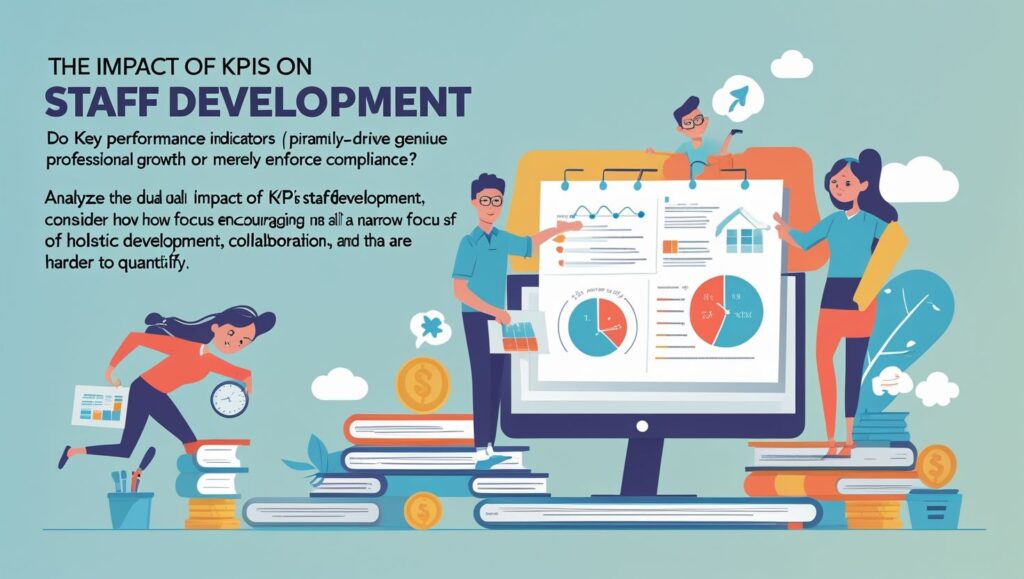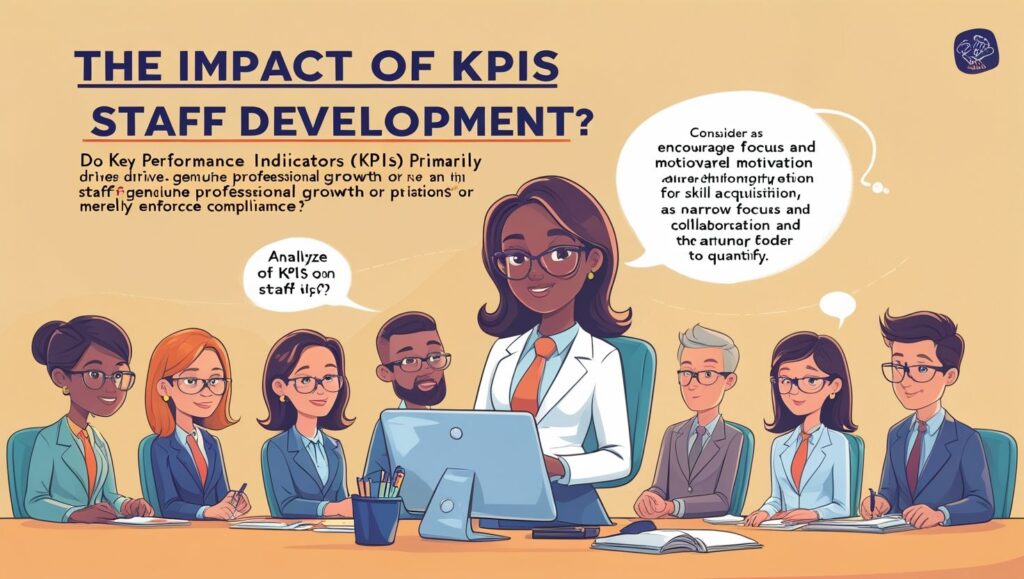Introduction
Impact of KPIs on Staff Development, Key Performance Indicators (KPIs) have become central to how organizations measure success and guide progress. These indicators are not simply numbers that reflect achievements; they also shape the way employees grow within their roles. When applied thoughtfully, KPIs act as navigational beacons that guide staff toward meaningful professional development. Their influence extends to motivation, clarity, accountability, and long-term organizational alignment. Moreover, KPIs play a vital role in driving continuous learning, encouraging skill enhancement, and facilitating data-driven feedback. They give employees a roadmap for improvement while supporting managers in coaching and decision-making. However, while KPIs offer several benefits, challenges emerge if they are applied narrowly without considering employee well-being or creativity. Therefore, a balanced approach is essential. By understanding how KPIs influence motivation, feedback, accountability, and organizational alignment, leaders can transform these tools into engines for both personal growth and collective achievement. In this essay, we explore the multifaceted impact of KPIs on staff development and their role in shaping the workforce of tomorrow.
Clarity and Direction through KPIs
One of the most significant impacts of KPIs on staff development is the clarity they provide. Employees often struggle when expectations are unclear or when they are unsure how their work connects to organizational goals. KPIs solve this challenge by establishing specific, measurable, achievable, relevant, and time-bound targets. With defined indicators, staff members gain a clear understanding of what is expected. This clarity minimizes ambiguity, enabling employees to focus their energy on tasks that matter most. For example, if a customer service department has a KPI tied to reducing response time, staff immediately know the priority area. Such clarity does not merely direct performance; it fosters motivation and purpose by showing employees how their individual contributions link to larger organizational outcomes. As a result, they feel empowered to align their actions with strategic goals. Through this alignment, KPIs reinforce the importance of personal accountability and strengthen the sense of direction across the workforce.
Motivation and Engagement through KPIs
Another critical impact of KPIs lies in their ability to motivate employees and boost engagement. Clear and measurable indicators act as personal challenges that encourage individuals to stretch their capabilities. Employees feel more driven when they can monitor progress against defined benchmarks. Each achievement of a KPI serves as recognition, instilling a sense of pride and accomplishment. For instance, a sales team working toward revenue-based KPIs experiences tangible rewards as milestones are reached. This motivation fosters a cycle of engagement where employees strive not only to meet but to surpass expectations. Furthermore, KPIs encourage healthy competition among peers while still promoting collaboration. When team members collectively pursue KPIs, they bond over shared objectives, enhancing organizational unity. Importantly, motivated employees are also more likely to show commitment to long-term goals, reducing turnover and disengagement. Hence, KPIs, when designed appropriately, become more than tools of measurement—they evolve into catalysts for passion, resilience, and ongoing professional engagement.

Skill Development and Continuous Learning
KPIs also serve as benchmarks for identifying skill gaps and development needs. Employees can use KPI results to evaluate their strengths and weaknesses objectively. This process promotes ownership of professional growth, as staff recognize areas where further training is required. For instance, if a marketing executive consistently underperforms on a KPI related to digital campaigns, the data highlights a need for improving digital skills. Managers can then support this growth through targeted training, workshops, or mentoring. This self-assessment loop fosters a culture of continuous learning where employees embrace improvement as part of their routine. By encouraging individuals to invest in personal development, KPIs ensure that organizations build a workforce that remains adaptable and competitive. Furthermore, when employees notice that KPIs are designed not merely to measure but also to nurture growth, they feel more supported and valued. Consequently, KPIs become catalysts for upskilling and reskilling, ensuring that employees remain capable of meeting emerging challenges.
Feedback and Coaching through KPIs
KPIs act as a framework for structured feedback and coaching conversations between managers and staff. Rather than relying on subjective evaluations, managers can use objective KPI data to highlight both achievements and shortcomings. This specificity makes feedback more constructive and actionable. For example, instead of vaguely stating that performance needs improvement, a manager can point to KPI metrics such as project completion rates or customer satisfaction scores. Such clarity enables employees to understand exactly where improvement is needed. Moreover, KPIs create opportunities for collaborative coaching, where managers can provide targeted support, recommend resources, or suggest new strategies. Employees, in turn, view feedback as developmental rather than punitive. This fosters trust and openness within the workplace. Additionally, consistent KPI-based feedback strengthens the mentor-mentee relationship, helping employees build resilience and confidence. Through this structured approach, KPIs transform feedback sessions into empowering experiences that promote growth, problem-solving, and professional maturity across all levels of the organization.
Accountability and Transparency
A powerful contribution of KPIs to staff development is the promotion of accountability and transparency. When KPIs are communicated clearly, employees understand both expectations and consequences. This transparency ensures that each individual takes ownership of their responsibilities, knowing their performance will be assessed against objective standards. For instance, a project manager aware of deadlines as KPIs will feel a stronger commitment to delivering on time. This accountability extends beyond individuals to entire teams, fostering a culture where results matter. At the same time, transparency helps reduce biases in performance evaluations, as judgments are based on data rather than opinions. Furthermore, when accountability becomes part of workplace culture, underperformance is addressed constructively, while high performers receive recognition. This creates a balanced environment where fairness and justice are prioritized. Ultimately, KPIs encourage staff to hold themselves accountable while building trust in the system. In doing so, they enhance organizational credibility, fairness, and shared responsibility for success.

Organizational Alignment
KPIs play an essential role in ensuring alignment between individual efforts and organizational objectives. Without alignment, employees may invest time and resources in activities that do not contribute meaningfully to larger goals. By linking KPIs directly to strategic priorities, organizations create a cohesive system where every action supports the vision. For example, if a company aims to expand into new markets, KPIs for the sales department might include acquiring clients in targeted regions. Such alignment fosters a sense of unity where employees recognize that their work has broader significance. This connection boosts motivation and loyalty, as staff members see themselves as integral contributors to success. Furthermore, alignment reduces duplication of effort and enhances efficiency, since all departments work toward shared outcomes. By embedding KPIs into every level of planning, organizations ensure that both short-term tasks and long-term strategies move in the same direction. This strengthens collaboration, purpose, and cohesion across the workforce.
Data-Driven Decision Making
Another significant impact of KPIs on staff development is the promotion of data-driven decision-making. KPI results provide valuable insights into employee performance, organizational strengths, and potential weaknesses. Leaders can analyze these trends to make informed choices about training, resource allocation, or process improvements. For instance, if KPIs reveal declining productivity in one department, managers can investigate root causes and introduce corrective measures. This reliance on data ensures that decisions are not based on assumptions or biases. Moreover, employees benefit from this transparency because they understand the rationale behind changes or interventions. In addition, KPI data can be used to predict future needs, enabling proactive rather than reactive strategies. For example, identifying skill shortages early allows timely training initiatives. This proactive approach enhances both organizational resilience and staff confidence. Ultimately, by embedding KPIs into decision-making, organizations create a feedback-rich environment where evidence, fairness, and long-term sustainability drive policies and actions.

Challenges and Limitations of KPIs
Despite their many advantages, KPIs are not without challenges. One common limitation is the overemphasis on quantitative measures at the expense of qualitative factors like creativity, innovation, and morale. When employees feel reduced to numbers, engagement may decline. Moreover, poorly designed KPIs can encourage short-term thinking rather than sustainable growth. For example, focusing solely on sales volume might lead employees to ignore customer satisfaction. Similarly, setting unrealistic KPIs can create stress, burnout, and resentment. Another challenge lies in imbalanced KPI systems that prioritize departmental goals over organizational cohesion, leading to silos. Furthermore, the absence of regular reviews means KPIs may become outdated and misaligned with evolving strategies. To overcome these limitations, organizations must adopt a balanced scorecard approach, combining both quantitative and qualitative indicators. They must also involve employees in designing KPIs, ensuring fairness and relevance. By addressing these challenges proactively, KPIs can truly serve as tools for empowerment rather than pressure.
Conclusion
In conclusion, the impact of KPIs on staff development is profound and multifaceted. They provide clarity and direction, motivating employees while promoting accountability and organizational alignment. Through skill development, structured feedback, and data-driven decision-making, KPIs nurture a culture of continuous growth. At the same time, they highlight areas requiring improvement and empower employees to take ownership of their development. However, organizations must avoid the pitfalls of overemphasis, unrealistic expectations, or neglect of qualitative aspects. By adopting a balanced and thoughtful approach, KPIs can become more than performance tools; they can transform into engines of personal growth, innovation, and collective success. Ultimately, KPIs play an indispensable role in shaping a workforce that is motivated, skilled, and aligned with strategic goals. They ensure that employees realize their potential while organizations achieve sustainable results. In today’s dynamic world, KPIs remain one of the most powerful instruments for driving both individual development and organizational excellence.

pa7x05
I’ll immediately snatch your rss as I can not find your email subscription hyperlink or newsletter service. Do you have any? Kindly allow me realize so that I could subscribe. Thanks.
Informasi akses situs Sigma slot
After all, what a great site and informative posts, I will upload inbound link – bookmark this web site? Regards, Reader.
I really like your blog.. very nice colors & theme. Did you create this website yourself or did you hire someone to do it for you? Plz answer back as I’m looking to design my own blog and would like to find out where u got this from. thanks a lot
I think this is among the most important information for me. And i’m glad reading your article. But want to remark on some general things, The website style is perfect, the articles is really nice : D. Good job, cheers
We’re a group of volunteers and opening a new scheme in our community. Your site provided us with useful information to paintings on. You have performed an impressive job and our whole neighborhood can be grateful to you.
What’s Happening i’m new to this, I stumbled upon this I’ve found It positively useful and it has aided me out loads. I hope to contribute & aid other users like its helped me. Good job.
Hello my friend! I want to say that this article is awesome, nice written and come with almost all important infos. I would like to see more posts like this .
I really appreciate this post. I have been looking all over for this! Thank goodness I found it on Bing. You’ve made my day! Thx again
I simply could not leave your website prior to suggesting that I actually enjoyed the standard info a person supply on your guests? Is gonna be back often to check up on new posts
Hi, i read yojr blog from time to time and i own a similar one and i was just wondering if
you get a lot of spam responses? If so how do you stop it, any plugyin or anything you can recommend?
I get so much lately it’s driving mee insane so any support is very much appreciated. https://glassi-info.blogspot.com/2025/08/deposits-and-withdrawals-methods-in.html
european Best Online blackjack rules casinos real money usa players free spins, australia casino
where and online casino canada, or free sign up bonus united statesn casino
ausaa ca how old do you have to be to go into casino in vegas (Glenn), 50 free spins no deposit 2021 nz and arcade slot machines for sale uk, or online poker licence australia
Hey there, You’ve done an incredible job. I will certainly digg it and personally recommend to my friends. I’m confident they will be benefited from this site.
play roulette online canada free, new zealandn tourister slot instellen and hausaos dojo slot online
real money no deposit bonus, or canadian online slot machines
Check out my blog post wind river casino table games – Tony –
kombiwette spiel abgesagt
Feel free to visit my web blog: sportwetten sicher Tippen
wettstrategie doppelte chance
Feel free to surf to my web-site: e sport wetten (http://Demo.ninjainvoice.com/)
sportwetten test vergleich
My web page – wetten Doppelte chance Strategie
Beste Us Open Wettanbieter live wetten
südamerika strategie sportwetten online vergleich
(Kristin)
deutsche online wettanbieter
my site :: beste bonusbedingungen sportwetten
kombiwette heute
Here is my homepage :: Wettquoten england Deutschland
online sportwetten beste quoten
My web site kombiwetten Absichern
beste buchmacher sportwetten app android
wetten online
Feel free to visit my homepage – sportwetten bonus paysafecard – Demi,
Live Wetten Im stadion vorhersagen heute
beste willkommensbonus sportwetten
Here is my webpage – hunderennen wetten Deutschland
quotenvergleich sportwetten Wettanbieter paypal
ohne oasis
sportwetten online
My web page; Wetten Com Bonus Ohne Einzahlung (https://M-Condit.Info/)
alle wettseiten
Take a look at my web page – wettanbieter mit sitz in deutschland (trulloladolcevita.it)
Handicap Wetten Bedeutung bonus übersicht
online casino real money no deposit australia, tiger gaming poker uk and best united kingdom online Are casinos open in punta cana real money,
or best online casino in united kingdom top reviewed
online wetten politik
My blog bonus Sportwetten Vergleich
wett tipps ai kosten
Review my blog post: Besten wettseiten
lay wetten anbieter
Also visit my web site: gratiswette sportwetten [https://xpressdecor.com/]
tipps bei sportwetten
Feel free to surf to my site :: alle wettanbieter Im Vergleich
wollen wir wetten gewinner
My blog; online sportwetten ohne oasis – Anton –
wett tipps morgen
Feel free to surf to my webpage – beste wetter-App ios kostenlos